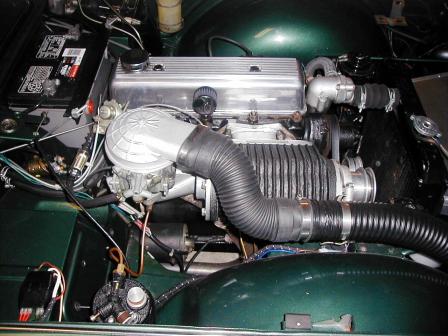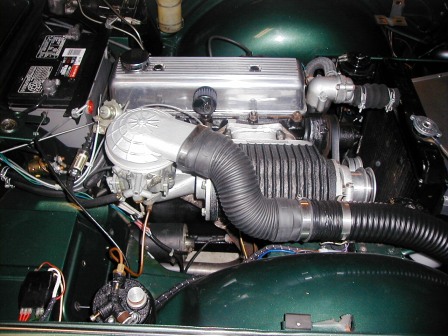Judson Supercharger
 Once the TR4A was
completed (is a project like this every completed?), I started
looking for the next project. The car was a complete success,
but after the first autocross at TRF, I knew I needed to upgrade
the suspension and look for more power!. The suspension was
easily upgraded with Addco front and rear sway bars, shorter
"comp" springs in the front and a new urethane bushing kit. At
the rear, since this is a solid axle TR4A, I had to get
creative. With the short springs, the front now sat several
inches lower, but the rear was still sitting high. The rear
springs were new TRF replacement springs and the car has been
sitting on the upper bump blocks since it was rebuilt. Even with
a full tank of gas and a passenger, it was still sitting high.
The solution was to build custom leaf spring shackles that are
longer than stock. These push the rear springs higher, thus
lowering the car. The end result is a TR4A that is much lower
than stock, sits with it's 195/VR65/15 tires filling the wheel
wells and is completely flat when cornering. These simple
upgrades transform the car and make it handle like a go-cart!
Okay, enough about the suspension, you want to hear about the
Judson, right? Okay, after the upgrades, I really wanted
something unique as there are more and more TR4A's showing up at
car shows every year. So my options were to do a set of Webers
or Once the TR4A was
completed (is a project like this every completed?), I started
looking for the next project. The car was a complete success,
but after the first autocross at TRF, I knew I needed to upgrade
the suspension and look for more power!. The suspension was
easily upgraded with Addco front and rear sway bars, shorter
"comp" springs in the front and a new urethane bushing kit. At
the rear, since this is a solid axle TR4A, I had to get
creative. With the short springs, the front now sat several
inches lower, but the rear was still sitting high. The rear
springs were new TRF replacement springs and the car has been
sitting on the upper bump blocks since it was rebuilt. Even with
a full tank of gas and a passenger, it was still sitting high.
The solution was to build custom leaf spring shackles that are
longer than stock. These push the rear springs higher, thus
lowering the car. The end result is a TR4A that is much lower
than stock, sits with it's 195/VR65/15 tires filling the wheel
wells and is completely flat when cornering. These simple
upgrades transform the car and make it handle like a go-cart!
Okay, enough about the suspension, you want to hear about the
Judson, right? Okay, after the upgrades, I really wanted
something unique as there are more and more TR4A's showing up at
car shows every year. So my options were to do a set of Webers
or something more exotic. A Judson Supercharger would certainly
qualify so I started a web search for one of the rare speed
parts from the 50's-60's. After several months, I ran across a
complete kit for a TR3/4 on Ebay. Turns out it was being sold by
Jason Len from XK's Unlimited, so I knew it would be a good
item. After the reserve was not met, we discussed it off line
and a deal was struck. It was a complete kit and had everything
I needed to install the supercharger on a TR4. Since I have a
TR4A, there would be some differences, but it would not be a big
deal to overcome. I am breaking down the next steps into phases
as the car evolved through several phases of development . something more exotic. A Judson Supercharger would certainly
qualify so I started a web search for one of the rare speed
parts from the 50's-60's. After several months, I ran across a
complete kit for a TR3/4 on Ebay. Turns out it was being sold by
Jason Len from XK's Unlimited, so I knew it would be a good
item. After the reserve was not met, we discussed it off line
and a deal was struck. It was a complete kit and had everything
I needed to install the supercharger on a TR4. Since I have a
TR4A, there would be some differences, but it would not be a big
deal to overcome. I am breaking down the next steps into phases
as the car evolved through several phases of development .
Phase 1: This was just bolting on the "kit" and seeing what
happened. First of all, the TR4A header that I had installed
would not work with the Judson. Neither would the stock exhaust
manifold. The header and the stock TR4A manifold extend from the
head about 2 inches and while these will clear the intake
manifold, on the Judson, they run into the wide intake plenum
that the blower bolts to. So I had to dig out a TR3/4 exhaust
manifold and use this. This meant that the exhaust had to also
be modified to allow a TR4 down pipe to mate to the TR4A "Y" pipe
to the rear mufflers. This ended up being a simple change that
works well. With this all done, the car could now be driven and
I discovered a huge increase in torque off idle. The car had a
lot of power, but would start pinging after a few minutes as it
warmed up. Thus
 Phase 2: This phase
consisted of either a head replacement or shimming of the ported
and shaved cylinder head to get the compression down to a
reasonable level. Since I had rebuilt the head and ported it, I
really wanted to retain this head rather than rebuild a stock
one (this was probably a mistake with some hindsight). Since the
head had .090 taken off, I bought a solid copper head gasket
that was .090 thick. This was combined with two stock head
gaskets to make a sandwich to shim the head off the block. The
result should be lower compression and better performance. This
did cut down on the pinging and the car was running better. I
drove the car like this for the rest of the summer and took it
to the Summer Party at TRF. After I broke the water pump (as
predicted by George Folchi), this began Phase 2: This phase
consisted of either a head replacement or shimming of the ported
and shaved cylinder head to get the compression down to a
reasonable level. Since I had rebuilt the head and ported it, I
really wanted to retain this head rather than rebuild a stock
one (this was probably a mistake with some hindsight). Since the
head had .090 taken off, I bought a solid copper head gasket
that was .090 thick. This was combined with two stock head
gaskets to make a sandwich to shim the head off the block. The
result should be lower compression and better performance. This
did cut down on the pinging and the car was running better. I
drove the car like this for the rest of the summer and took it
to the Summer Party at TRF. After I broke the water pump (as
predicted by George Folchi), this began
Phase 3: Phase 3
consisted of having George build a custom front pulley and new
supercharger pulley to allow the supercharger to be driven
directly off the crank (instead of the water pump). This fixes a
major flaw of the TR design for the Judson and also allows an
opportunity for additional boost. George resized the front and
supercharger pulleys to allow a bit of over boost verse stock so
we were looking at more like 5-6 pounds verse the original boost
of 4-5 pounds. With this hardware installed, the car could now
be driven again and we continued to use the car for the Fall
driving season.
Phase 4: Over the
winter, I started plotting the next changes. Since the car was
still pinging especially when it warmed up, I decided to attack
the problem from several angles. To address cooling, I built an
aluminum box for the radiator to force air into the radiator
more effectively than the stock cardboard box!. I also decided
that the supercharger needed more fuel than the single barrel
carb could offer. Using a single to double barrel adapter, a
Weber 36 DGV carb with custom jetting, this should resolve the
fuel issues. To further enhance cooling, the stock header was
wrapped in header wrap, and the carb was topped with an aluminum
adapter and a hose ran to a K&N carb that was mounted in the
aluminum radiator box, just behind the grill. This should ensure
a supply of cool air to the engine. Finally, boost gage
and oxygen sensor were installed so I could see the
fuel/air ratio and see how much boost was being generated. All
of this was done during the spring and the car was ready to be
driven by early summer. Results were mixed as it definitely had
more power and when the engine was cold, it was a beast!. But
when it was driven a few miles (15-20 miles), it would start to
run hot and this would generate some pinging and cut back on the
power. We drove the car the rest of the year, even took it to
the Summer Party and drove it at the Autocross and to the
various events. The car even took 3rd place in the car show. It
is very unique and gathers a crowd anywhere it goes, but I am
still not satisfied with the overall performance.
Phase 5: This phase
was not completed, but here is what would probably have to be
done to make this a successful conversion. The car suffers from
heat soak, so when it is pushed hard, the extra heat has no
where to go, so it ends up running hot. The car needs an
oversized radiator that has sufficient capacity to handle the
added heat the supercharger generates. Secondly, I would go back
to a stock cylinder head and cam, as my ported and polished head is
probably too much for this application. All of this, and
possibly combined with a knock sensor/ignition computer and/or
distributor to
control the spark advance would probably make this a different
beast. One other contributing factor is that the car really
needs another gear. So I would also need to do an overdrive
conversion or one of the Toyota 5-speed conversions. So why did I not complete Phase 5? Check out the Rover V8
link!
|

